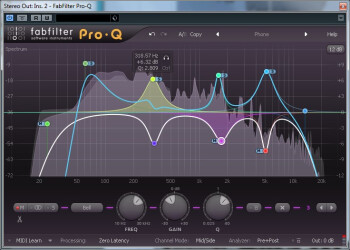In this new installment of our article series dedicated to mastering at home, we will delve into the world of mid-side processing.
The theory
You have probably noticed that the plug-ins we have addressed up to now work in stereo, but some of them offer the possibility to work in mid-side (often called M/S). What is then M/S and what are its advantages?
In an audio mastering situation, you will work mainly with stereo files. And you will certainly be able to apply different processing to the right and left channels, which might not be that interesting if you consider that it will inevitably entail a severe imbalance of the stereo image. However, mid-side processing splits the stereo signal into two components, a center one (mid or M) and a lateral one (side or S), in order to be able to work on each of them separately. Thus, there is almost no risk of unbalancing the stereo image. I write “almost” because, even if mid-side intrinsically preserves the central point of the stereo field, you can nevertheless alter the lateralization of the mid component, for better or for worse.
Is the mid-side concept still a bit abstract? Some practical experience will help you sort it out. In this sense, we strongly recommend you to download the free bx_solo plug-in developed by Brainworx and use it from within your sequencer on any stereo file you wish. This plug-in will allow you to listen to the mid and side components of the signal in turns by clicking on the “M Solo” and “S Solo” buttons respectively. Can you start to glimpse the possibilities that mid-side offers?
In practice
That’s all very nice, but how can you actually apply that in a mastering situation? Well, there are so many applications that it would be impossible to write down an comprehensive list in just a couple of lines. Nevertheless, here are a couple of examples that we hope you’ll not only find useful, but will open up new horizons for you.
Using an EQ in mid-side allows you, for example, to attenuate the low end of the frequency range on the sides without touching the center (mid). This will result in more precision and punch (because the kick and the bass will be firmly anchored in the middle), as well as in a more airy sensation (due to a more pronounced disassociation of the mid and side).
For its part, a compressor will help you have a better control over the rhythmic foundation (drums and bass), while preserving the dynamics of guitars, pianos and other similar instruments.
A reverb in mid-side will make the side signal ease off more naturally, without drowning the middle. As a consequence, you will get the best of both worlds: More depth on the sides with more precision and impact in the center.
The use of a harmonic exciter with different settings for mid and side can also be interesting. You could, for instance, add more harmonics to the vocals in the center than to the rest. Thus, the singer will gain presence and come through the mix more clearly.
As you can see, the possibilities are huge. And if you add to that the mutli-band possibilities certain processors offer, your scope of action becomes almost endless. It’s a topic that requires lots of hours of dedication to learn to make the best of it. Experimenting is key, so enjoy yourself!


